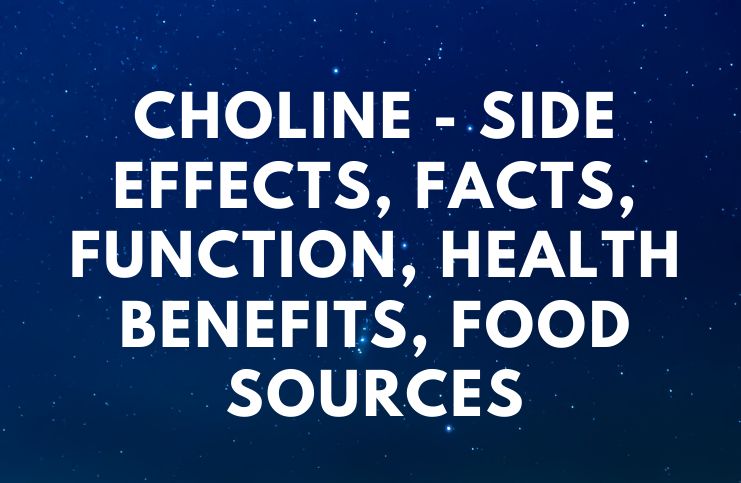Choline – Side Effects, Facts, Function, Health Benefits, Food Sources:
Facts
Choline is an essential water-soluble nutrient, which your body produces in small amounts. However, you must consume it through your diet to get enough.
This is similar to Vitamin–B and is very effective in the creation process of new cell membranes in both humans and animals.
It was first discovered in 1862 by the chemist Adolph Strecker, who spread awareness about its nutritional significance.
In present days, it has been given GRAS status (Generally Regarded as Safe) by the U.S. Food and Drug Administration.
Daily Recommended Amount
- Infants and babies: 125-150 mg;
- Children ages 1-8: 150-250 mg;
- Teens ages 8-13: 250-375 mg;
- Men above age 14: 550 mg;
- Women above age 14: 425-550 mg;
- Pregnant women: 450-550 mg;
- Women who are breastfeeding: 550 mg.
Supplements vs. foods
Unsurprisingly, this substance is best obtained from whole foods in its synergistic form, where the full array of cofactors and complementary nutrients are absorbed optimally.
Deficiency
A slight deficiency of this nutrient can be identified by a few symptoms, such as low energy levels of fatigue, frequent memory loss, mood changes or disorders, concentrated urine, and nervous disparity.
Extreme deficiency symptoms can range anywhere from poor growth, infertility, respiratory problems, anemia, and impaired bone formation.
Moreover, deficiency in this compound may cause abnormal deposition of fat in the liver, which leads to a disorder named – nonalcoholic fatty liver disease.
Healthy Food Sources
Legumes such as lima beans, garbanzo beans, and lentils have about 70 mg per cup, pumpkin seeds, sunflower seeds, and almonds have around 60 mg per cup, cauliflower and broccoli (1 cup) 48mgs, wheat germ (2 tbsp) 26 mg, and peanut butter (2 oz) 20 mg.
Moreover, it is found in soy products, particularly soy lecithin, as a lubricant, or emulsifier, when added to food, plus, soy lecithin has important functions as a flavor protector or antioxidant.
Specialists do not recommend consuming animal products, as some research suggests that foods high in this substance may increase cancer growth. The top 5 foods that cause this process: are whole eggs, skim milk, beef, reduced-fat milk, and poultry without skin. (1)
Functions, uses, and health benefits
Increases memory
It may also play a role in memory. Dementia and memory loss may indicate a deficiency of this nutrient.
According to a recent study, individuals who had reported a diet that was higher overall in this nutrient had lower incidents of white-matter hyperintensity and an improved cognitive function.
Pregnancy and lactation
The demand for this substance is especially higher during pregnancy and lactation. Because human milk is rich in this nutrient, lactation further increases maternal demand, resulting in extended depletion of tissue stores.
In addition, the nutrient is needed for forming new brain connections between neurons called synapses. Some reports even show that it can help prevent learning disabilities and can improve concentration in teens and children.
Nervous system
This substance acts as a precursor to certain essential neurotransmitters, including acetylcholine, which is used in healthy muscle and nerve function.
Neurotransmitters are chemicals located and released in the brain used throughout the body constantly to relay information from system to system.
Heart disease
When the body is low in this nutrient, plasma levels of homocysteine increase.
Increased levels of homocysteine have been linked with greater risk for a few chronic diseases and conditions, including cancer, cardiovascular disease, cognitive decline, and bone fractures.
Inflammation
Findings from the ATTICA (2008) study indicated that subjects whose diets were rich in betaine and this nutrient had the lowest levels of several inflammatory markers, among others – homocysteine, C-reactive protein (CRP), interleukin-6 and tumor necrosis factor. However, further studies are needed to confirm or refute these findings. (2)
Weight loss
Obesity is strongly associated with major cardiovascular risk factors such as glucose intolerance, raised blood pressure, dyslipidemia, and type 2 diabetes mellitus.
In 2014, approximately 2 billion adults, 18 years and older, were overweight. Of these, over 30 percent were obese.
There have been some studies that concluded that this nutrient may promote a reduction in body fat percentage and support weight loss effects.
Side effects of choline
Excessive consumption of this substance can cause vomiting, insomnia, feelings of agitation, low blood pressure, dizziness, and diarrhea.
If you vastly exceed the recommended amount (around 10 grams per day), you can possibly experience excessive perspiration and a fishy odor of the skin.
Very high doses may lead to a fishy body odor and abnormal results on liver function tests. High dosages should not be used by patients diagnosed with Parkinson’s disease, trimethylaminuria, and liver or kidney disease.
In addition, people with a history of allergy to lecithin should avoid taking this supplement before asking a healthcare specialist.
Important note
According to recent research, the amount of folic acid you consume may dictate how much choline your body makes and needs from food sources.
Therefore, someone who obtains more folic acid from leafy green vegetables and certain grains, for instance, will need less choline from food. (3)
READ THIS NEXT:
Spirulina Powder – Side Effects, Health Benefits, Uses, Facts
Saponins – Side Effects, Facts, Health Benefits, Food Sources
Bromelain – Side Effects & Health Benefits
List of Foods High in Resveratrol – The Natural Source of Longevity


